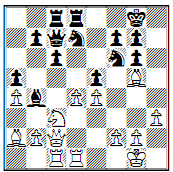We have all been taught to keep our castled positions safe, and not to move Pawns in front of our castled Kings except to avoid a back-rank mate or when otherwise absolutely necessary. Right? Well, it's true. And if you're going to move these Pawns, do it when you choose (such as when you're going to attack the opponent's King), not when your opponent makes you do it. In the game we are about to examine, the specific castled-position weakness that crops up is the doubling of the g-Pawns. As long as Pawns stand on f7 and h7 (or f2 and h2 on the White side), the square g6 (or g3) is reasonably secure, but should the h-Pawn have to shift to the g-file in making a capture, the square g6 (or g3) becomes a much greater liability. If White can pin the f7 on the castled King, an invasion on g6 may be not far behind. White manages to pry open just enough of a weakness in Black's castled position to be able to smash it to pieces later.
The winner of this game is SM Denys Shmelov, who loyally came to the Waltham Chess Club's Friday night tournaments through most of 2010 and who recently earned his first GM norm at Berkeley. We wish Denys congratulations and all the best as he embarks on graduate school at the University of Connecticut.
White: Denys Shmelov
Black: Tian Rossi
Waltham Chess Club
Memorial Day G/60
5/21/2010
1.d4 d5 2.c4 c6 3.Nf3 Nf6 4.Nc3 dxc4 5.a4 Bf5 This is a main move in the Slav Accepted, and is perfectly fine provided that Black minds that fieryeyed steed on f3. 6.e3 e6 7.Bxc4 Bb4 8.0-0 0-0 9.Nh4 The horse charges! What should Black play? 9...Bg6 Not this. If White had played Nh4 back on move 8 (instead of castling), then this Black response would be fine as Black would then castle Q-side. But here, with Black already castled K-side, the move is an error conceding a P weakness in front of the castled K. Instead Black should stand pat and allow White to take on f5, or try the aggressive 9. ... Bg4!? [9...Bg4 10.f3 Bh5 11.g4 Nd5 12.Ng2 Bg6 13.Qb3 a5 14.Rd1 Nd7 15.e4 N5b6 16.Be2 Qe7 17.Nf4 e5 18.Nxg6 hxg6 19.Be3 Rfd8 20.Na2 exd4 21.Nxb4 dxe3 22.Nc2 Qe6 23.Qxe3 Qe7 24.Qb3 Qc5+ 25.Nd4 Ne5 26.Rac1 Qb4 - Stockfish.] 10.Nxg6 hxg6 Because of this Black can no longer prevent the c1- B from coming to g5. 11.Qc2 Nbd7 12.Rd1 Qc7 13.h3 Prophylaxis, preventing ... Ng4. Note that Black cannot follow suit, with his P on g6. 13...Rac8 14.e4 White usually achieves this move at some point in the Slav, but his being able to do it against a weakened castled position makes it more powerful than normal. 14...Nb6 15.Ba2 a5 16.Be3 Rfd8 This move is awkward for Black in view of the pin coming up on g5. 17.Rac1 Nbd7 Both players overlooked 17. ... Bxc3 18. bxc3 isolating White's a-P, since 18. Qxc3? hangs the P's on a5 and e5. White should instead have played 17. Bb3, when Black's best reply is 17. ... Be7 to guard against the Bg5 pin (Stockfish). 18.Bg5 Threatening 19. e5, and Bg5-h4-g3 is an additional latent threat. 18...e5 An unfortunate concession for Black, since now f7 is exposed and g6 may also become weak in the future. [18...Re8 is better, although 19.e5 is a strong reply - Stockfish.] (D)

19.Qb3 White overlooks 19. Nd5! [19.Nd5 - note how this move too takes advantage of the pin on g5 - 19...Nxd5 20.Bxd8 Rxd8 21.exd5 exd4 22.dxc6 bxc6 23.Rxd4 Ne5 24.Qe4 Rxd4 25.Qxd4 g5 26.Bb1 Kf8 27.Be4 g6 28.Qd1 c5 29.Qb3 g4 30.Bd5 - Stockfish.]
19...Nf8 Leaving e5 exposed. 19. ... Rf8 is more secure; 20. dxe5 is the likely response (Stockfish). 20.dxe5 Again White misses a stronger chance: 20. Bxf6. [20.Bxf6 gxf6 21.Nd5 Rxd5 22.exd5 Qe7 23.dxc6 bxc6 24.dxe5 fxe5 25.Qc4 Rc7 26.Qe4 Qf6 27.Rd3 Qf5 28.Qxf5 gxf5 29.Bd5 Ne6 30.Bxe6 fxe6 31.f3 Kf7 32.Kf2 Kf6 - Stockfish.] 20...Rxd1+ Concession of the d-file. But 20. ... Qxe5?? is unfortunately a lemon. [20...Qxe5 21.Qxf7+ Kh7 22.Bxf6 Qxf6 23.Qg8+ Kh6 24.Rxd8 Rxd8 25.Qh8+ Nh7 26.Bg8 Rxg8 27.Qxg8 Qf4 28.Re1 Qe5 29.Re3 Bc5 30.Re2 Bd4 31.Qa8 Bxc3 32.bxc3 Qxc3 33.Qxb7 Qa1+ 34.Kh2 Qxa4 35.Qd7 Nf6 36.Qd2+ Kh7 37.e5 Nd5 38.e6 Ne7 39.Qg5 Qc4 40.Re1 - Stockfish.] 21.Rxd1 Bxc3 22.bxc3 Stronger is 22. exf6. [22.exf6 Ne6 - Stockfish.] 22...Nxe4 23.Be3 With Bb6 in mind for the future. 23...Ne6 24.f4 An important move for later; White holds the advance f5 in reserve. 24...N4c5 25.Qc2 Rd8 Loses a P; the weakening of f7 and g6 at last comes due. [25...b5 looks stronger, although 26.Bxc5 is a tough reply - Stockfish.] 26.Rxd8+ Qxd8 27.Bxc5 Nxc5 28.Qxg6 Qd7 More solid is [28...Qe7 29.Qf5 Nxa4 30.e6 Kf8 31.Qxa5 Qc5+ 32.Qxc5+ Nxc5 33.exf7 Ne4 34.c4 Nc3 35.Bb3 Ne2+ 36.Kf2 Nxf4 37.Kf3 Ne6 38.Ke3 c5 39.Bd1 Kxf7 40.Bf3 b6 41.Ke4 Nd4 42.Kd5 Kf6 43.Be4 Ne2 44.Kd6 g5 45.Bd5 Kf5 46.g4+ Kf6 47.Kc6 Nf4 - Stockfish.] 29.f5 Kf8 Black can get away with 29. ... Qd1+. [29...Qd1+ 30.Kh2 Qd7 - Stockfish.] 30.Qh5 Ne4 Black's last try was 30. ... Kg8 31. h4. Now, with e6 left unprotected, his position collapses. [30...Kg8 31.h4] 31.e6 fxe6 32.Bxe6 Qc7 33.Qh8+ Ke7 34.Qxg7+ Kd6 35.Qd4+ A great game by White, forcing one small concession after another from Black until eventually the house caved in. So you see, the old wisdom holds true. Keep that King of yours nestled snug behind unmoved Pawns. As long as you don't allow a back-rank mate, your King will thank you. 1-0
|